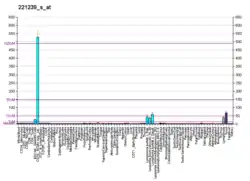FCRL2
Fc receptor-like protein 2 is a protein that in humans is encoded by the FCRL2 gene.[3][4]
| FCRL2 | |||||||||||||||||||||||||
|---|---|---|---|---|---|---|---|---|---|---|---|---|---|---|---|---|---|---|---|---|---|---|---|---|---|
| Identifiers | |||||||||||||||||||||||||
| Aliases | FCRL2, CD307b, FCRH2, IFGP4, IRTA4, SPAP1, SPAP1A, SPAP1B, SPAP1C, Fc receptor like 2 | ||||||||||||||||||||||||
| External IDs | OMIM: 606509 HomoloGene: 57121 GeneCards: FCRL2 | ||||||||||||||||||||||||
| |||||||||||||||||||||||||
| |||||||||||||||||||||||||
| |||||||||||||||||||||||||
| Orthologs | |||||||||||||||||||||||||
| Species | Human | Mouse | |||||||||||||||||||||||
| Entrez |
| ||||||||||||||||||||||||
| Ensembl |
| ||||||||||||||||||||||||
| UniProt |
| ||||||||||||||||||||||||
| RefSeq (mRNA) |
| ||||||||||||||||||||||||
| RefSeq (protein) |
| ||||||||||||||||||||||||
| Location (UCSC) | Chr 1: 157.75 – 157.78 Mb | n/a | |||||||||||||||||||||||
| PubMed search | [2] | n/a | |||||||||||||||||||||||
| Wikidata | |||||||||||||||||||||||||
| |||||||||||||||||||||||||
References
- GRCh38: Ensembl release 89: ENSG00000132704 - Ensembl, May 2017
- "Human PubMed Reference:". National Center for Biotechnology Information, U.S. National Library of Medicine.
- Xu MJ, Zhao R, Zhao ZJ (Feb 2001). "Molecular cloning and characterization of SPAP1, an inhibitory receptor". Biochem Biophys Res Commun. 280 (3): 768–75. doi:10.1006/bbrc.2000.4213. PMID 11162587.
- "Entrez Gene: FCRL2 Fc receptor-like 2".
Further reading
- Davis RS, Wang YH, Kubagawa H, Cooper MD (2001). "Identification of a family of Fc receptor homologs with preferential B cell expression". Proc. Natl. Acad. Sci. U.S.A. 98 (17): 9772–7. Bibcode:2001PNAS...98.9772D. doi:10.1073/pnas.171308498. PMC 55528. PMID 11493702.
- Miller I, Hatzivassiliou G, Cattoretti G, et al. (2002). "IRTAs: a new family of immunoglobulinlike receptors differentially expressed in B cells". Blood. 99 (8): 2662–9. doi:10.1182/blood.V99.8.2662. PMID 11929751.
- Guselnikov SV, Ershova SA, Mechetina LV, et al. (2002). "A family of highly diverse human and mouse genes structurally links leukocyte FcR, gp42 and PECAM-1". Immunogenetics. 54 (2): 87–95. doi:10.1007/s00251-002-0436-x. PMID 12037601. S2CID 9452957.
- Strausberg RL, Feingold EA, Grouse LH, et al. (2003). "Generation and initial analysis of more than 15,000 full-length human and mouse cDNA sequences". Proc. Natl. Acad. Sci. U.S.A. 99 (26): 16899–903. doi:10.1073/pnas.242603899. PMC 139241. PMID 12477932.
- Clark HF, Gurney AL, Abaya E, et al. (2003). "The secreted protein discovery initiative (SPDI), a large-scale effort to identify novel human secreted and transmembrane proteins: a bioinformatics assessment". Genome Res. 13 (10): 2265–70. doi:10.1101/gr.1293003. PMC 403697. PMID 12975309.
- Zhang Z, Henzel WJ (2005). "Signal peptide prediction based on analysis of experimentally verified cleavage sites". Protein Sci. 13 (10): 2819–24. doi:10.1110/ps.04682504. PMC 2286551. PMID 15340161.
- Gerhard DS, Wagner L, Feingold EA, et al. (2004). "The status, quality, and expansion of the NIH full-length cDNA project: the Mammalian Gene Collection (MGC)". Genome Res. 14 (10B): 2121–7. doi:10.1101/gr.2596504. PMC 528928. PMID 15489334.
- Gregory SG, Barlow KF, McLay KE, et al. (2006). "The DNA sequence and biological annotation of human chromosome 1". Nature. 441 (7091): 315–21. Bibcode:2006Natur.441..315G. doi:10.1038/nature04727. PMID 16710414.
- Taylor AI, Gould HJ, Sutton BJ, Calvert RA (2007). "The first avian Ig-like Fc receptor family member combines features of mammalian FcR and FCRL". Immunogenetics. 59 (4): 323–8. doi:10.1007/s00251-007-0195-9. PMID 17273841. S2CID 1971426.
This article is issued from Wikipedia. The text is licensed under Creative Commons - Attribution - Sharealike. Additional terms may apply for the media files.


